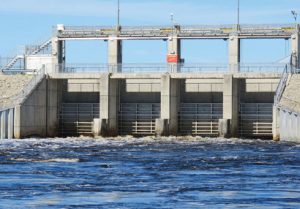U.S. Army Corps of Engineers to reduce Lake Okeechobee flows

Lake Okeechobee’s Moore Haven Lock and Dam. Photo Provided by the Army Corps of Engineers
The U.S. Army Corps of Engineers will start reducing outflows from Lake Okeechobee to the estuaries, starting Saturday.
The U.S. Army Corps of Engineers announced Thursday that the releases from Lake Okeechobee will begin “gradually to allow time for the ecosystems of the Caloosahatchee and St. Lucie rivers and estuaries to adjust.”
Currently, the flows for the Caloosahatchee Estuary have been averaging more than 4,000 cubic feet per second according to Calusa Waterkeeper John Cassani. Based on Thursday’s announcement, the flows will be reduced to approximately 3,000 cubic feet per second (cfs) as measured at the Moore Haven Lock & Dam (S-77). At the same time, the Corps will implement a multi-week release pattern for the St. Lucie Estuary, starting with a 5-day pause to allow for recovery of estuary health, followed by a 7-day average release of 1,500 cfs as measured at St. Lucie Lock & Dam (S-80) near Stuart.
“We will reduce the releases from Lake Okeechobee over the next month,” said Col. Andrew Kelly, commander of the Jacksonville District. “The 2020-2021 dry season has begun, and we will manage the lake in tandem with the needs and concerns of the people and ecosystems of South Florida.”
Cassani said that even at 3,000 cubic feet per second, the releases are still exceeding the “harm level,” which his organization considers to be at 2,800 cubic feet per second.
Cassani said the releases announced Thursday are “not going to help us too much on this side” though he said it is a “good idea” to reduce the flows.
Cassani said it “will take a period of recovery for our estuary to replenish itself.” He said the full effects of the damage from the Lake Okeechobee releases won’t be known for another two to three years.
Calusa Waterkeeper Executive Director K.C. Schulberg welcomed the “good news. The rainy season is over,” he said.
Schulberg said the releases from Lake Okeechobee since October “have been damaging.” Schulberg said the organization has photographed “huge plumes into the gulf” which he called “dramatic.” He said the difference between the “dark water and the blue water have been dramatic.”
“We will continue to look at the system holistically and expect to be able to refine the dry season strategy for the South Florida system around February,” said Kelly. “By then, we should have a much better feeling for the effects, if any, of the La Niña, and the results of our gradual transition plan. We’ll be in a better position to evaluate the trends and conditions in the lake, the Everglades and the estuaries, including water supply and our ability to move water south.”
Lake Okeechobee is currently at 16.02 feet above sea level, according to the U.S. Army Corps of Engineers. During the past week, lake levels receded 0.18 feet, with a 0.19-foot drop in the past 30 days.
Meanwhile, Cassani noted there have some reports of red tide in the region. According to the Florida Fish and Wildlife Conservation, red tide has been observed at very low concentrations in the region, with medium concentrations reported off Sanibel and Captiva. Cassani said there have been increasing reports of marine life mortalities.


